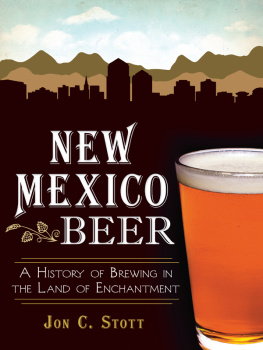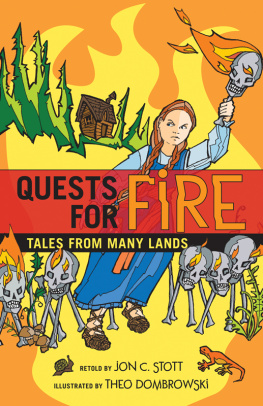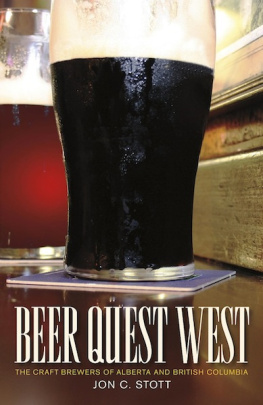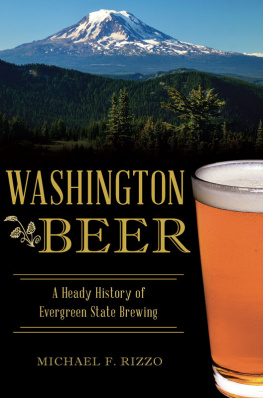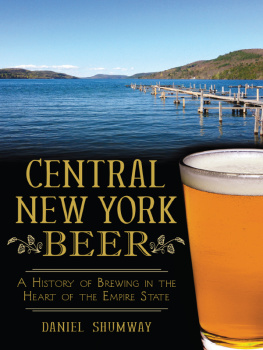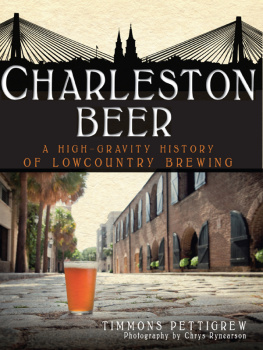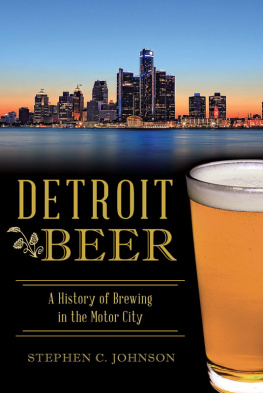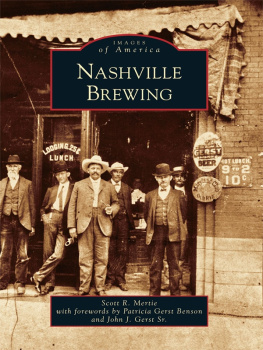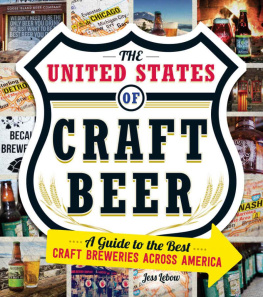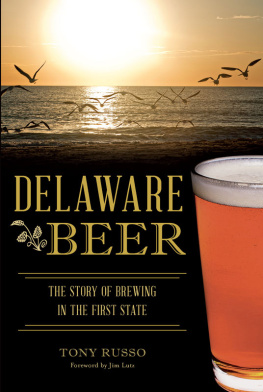
Published by American Palate
A Division of The History Press
Charleston, SC 29403
www.historypress.net
Copyright 2014 by Jon C. Stott
All rights reserved
First published 2014
e-book edition 2014
ISBN 978.1.62584.734.8
Library of Congress Cataloging-in-Publication Data
Stott, Jon C.
New Mexico beer : a history of brewing in the Land of Enchantment / Jon C. Stott.
pages cm
Includes index.
print edition ISBN 978-1-60949-814-6
1. Breweries--New Mexico. 2. Beer--New Mexico--History. 3. Brewing industry--New Mexico--History. I. Title.
TP577.S79 2014
338.476634209789--dc23
2014010410
Notice: The information in this book is true and complete to the best of our knowledge. It is offered without guarantee on the part of the author or The History Press. The author and The History Press disclaim all liability in connection with the use of this book.
All rights reserved. No part of this book may be reproduced or transmitted in any form whatsoever without prior written permission from the publisher except in the case of brief quotations embodied in critical articles and reviews.
For Clare and Alberto, with whom I most enjoy sharing New Mexicos great beers.
CONTENTS
PREFACE
First, I wish to thank Jerry Roberts, my commissioning editor at The History Press, who enthusiastically accepted my proposal for a book on New Mexico breweries, offered wise counsel and patiently guided me through the process of writing and preparing the manuscript through to its submission. To Ryan Finn, who edited the manuscript and made many suggestions for the improvement of what I had written, I also say thank you. These people have made New Mexico Beer a better book.
I wish to thank all the brewpub and brewery owners and brewers who graciously took time to answer my many questions, to show me their facilities and to offer me samples of their very good beers. Two people in particular have been exceptionally helpful: Christopher Goblet, executive director of the New Mexico Brewers Guild, and Bob Evaleth, the president of the Socorro Historical Society. As always, my daughter offered constant support and frequently offered to assist me in the liquid research that goes into writing a book about beer.
I read many newspaper and magazine articles and books about the beer and the craft beer movement. Three of the most valuable are Garrett Oliver, ed., The Oxford Companion to Beer (New York: Oxford University Press, 2011); Maureen Ogle, Ambitious Brew: The Story of American Beer (Orlando, FL: Harcourt, 2006); and Tom Acitelli, The Audacity of Hops: The History of Americas Craft Beer Revolution (Chicago: Chicago Review Press, 2013). Donna Blake Birchells New Mexico Wine: An Enchanting History (Charleston, SC: The History Press, 2013) provided a very helpful introduction to New Mexicos other major beverage industry. The blog of the Dark Side Brew Crew (www.nmdarksidebrewcrew.com) provided regular updates on the beers offered by New Mexico breweries and brewpubs.
PROLOGUE
EXPLORING THE FRONTIER OF BEER
You, said my friend who loves to use big words, are a loca-cervezaphile. Not being familiar with the word, I didnt know whether to be insulted or flattered, so I asked for a definition. He explained that a locavore was a person who, as often as possible, ate food grown close to home. A cervezaphile was someone who loved good beer. You not only like good beer, but youre always telling me that you like to buy beer as close to where its brewed as possible. So Ive decided to call you a loca-cervezaphile.
I was flattered, and I agreed. For well over a decade, Ive made a point of buying beer brewed in the state or province in which I was living. And when I travel, I always stop at a liquor store, carefully read the labels of the beers and chose a six-pack of something thats local. I either take it to my destination or, as is most frequently the case, enjoy a couple of bottles at the nights motel.
In 2001, I began spending the winter months at my daughters home in New Mexico and, of course, engaged in my loca-cervezaphile activities. What I noticed when I returned each winter was that the number of New Mexico beers available had increased considerably and that nearly all of them were very good.
Several years ago, I wrote Beer Quest West, a book about the craft breweries, brews and brewers of western Canada. When (after a very early and cold autumn in Edmonton, Alberta) I decided to move permanently to Albuquerque, I thought that I would expand my investigations into the beer culture of New Mexico, what the New Mexico Brewers Guild calls the Frontier of Beer. In preparation for my explorations of this frontier, I searched the Internet for a guidebook about New Mexico breweries and beer. Id seen others for the Pacific Northwest, Michigan and Connecticut, places I have visited frequently, but there wasnt a book for New Mexico. I did, however, discover that The History Press had published beer histories/guides for several cities and states in its American Palate series. It would, I thought, be fun to write one about New Mexico, becoming the Lewis and Clark of my explorations of the Frontier of Beernot just learning during my travels but also sharing my discoveries with others.
The people at The History Press agreed, and in late 2012, I began my explorations. I visited breweries in big cities and small towns, as well as some that werent even in small towns. I discovered breweries in a late nineteenth-century butcher shop, a 1920s J.C. Penneys department store, a 1940s blacksmith shop in a log cabin, an outbuilding in a Benedictine monastery and many converted warehouses. The brewers I met had come to the profession from formal training and home-brewing. One was a music teacher in his life before joining the brewing business, another was a real estate broker and a third was a stay-at-home mother. Several had been computer programmers and technicians. But all shared two common characteristics: they loved making beer and strove to make the best beer they could.
I sampled a variety of styles of beer. Every brewery had its version of India pale ale, and most of them had an amber ale or a stout. But I also tried a Dortmunder Export, a California common beer, some saisons, a kolsch and even a beer that included prickly pear cactus as one of its ingredients. I read many newspaper and magazine articles and several books about the brewing of beer, beer styles and beer history. And I made copious notes.
New Mexico Beer contains the results of my visits and research. After an introductory chapter presenting the two eras of New Mexico brewing historyfrom the 1850s to Prohibition and then the years since 1988, when Santa Fe Brewing Company openedthere are profiles on each of the thirty-three New Mexico breweries that were operational at the end of September 2013, my cut-off date. These essays are grouped in chapters for seven regional areas of the statethree for Albuquerque (west of Interstate 40, east of Interstate 40 and the surrounding areas). There are chapters for Santa Fe, Taos and for breweries scattered in the northern and in southern parts of the state. Each essay presents the background of the brewery, profiles of owners and brewers and descriptions of the main beers, along with some unusual ones. An provides descriptions of the main beer styles, along with the names of some New Mexico examples of each style.
In these essays, two abbreviations are frequently used. ABV refers to the percentage of alcohol by volume. The pale American lagers of the megabrewers are around 5 percent ABV; beers categorized as double or imperial are above 7 percent ABV. IBU refers to International Bitterness Unit, which is used to measure the level of bitterness the hops contribute to a beer. India pale ales are frequently the strongest, often reaching the level of 100 IBUs. The beers of the megabrewers are extremely low in IBUs, sometimes as low as 15 percent. Barrel is another frequently used term. As the basic unit of measure in the beer industry, a barrel is thirty-one gallonsthats fifty-four six-packs, with three bottles left over.
Next page
